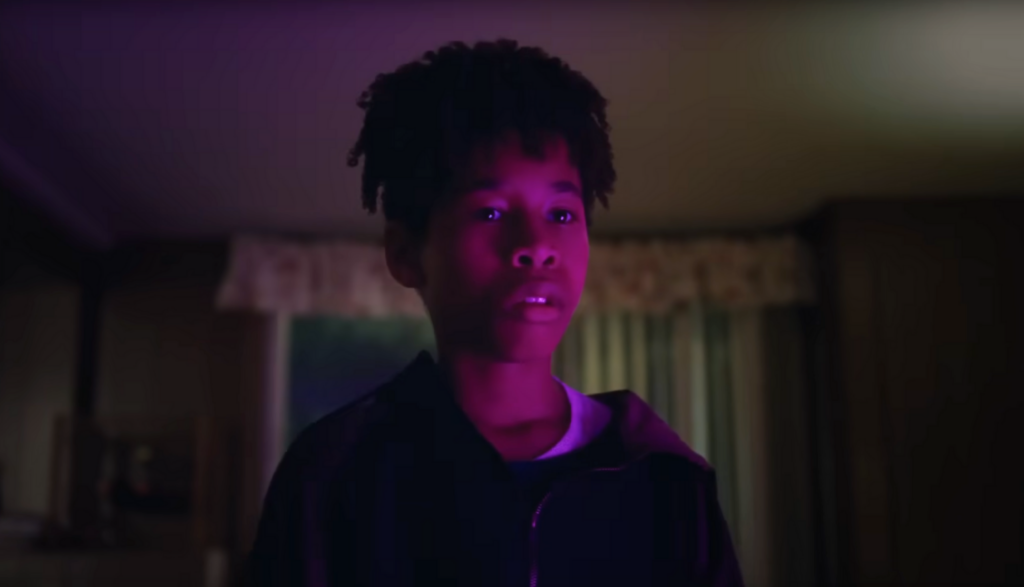
It’s just a TV show.
Yeah, right. Tell that to Maddy and Owen.
The show in question, The Pink Opaque, chronicles the supernatural adventures of Isabel and Tara, two teen girls who battle the big bad, Mr. Melancholy, and his legion of monsters. And while some might dismiss the show as an adolescent X-Files, Maddy would say that it’s far more than that. “Sometimes,” the adolescent outcast admits to Owen, “The Pink Opaque feels more real than real life.”
But the show comes on at 10:30 p.m.—way past the curfew for 7th-grade Owen. He’s never seen The Pink Opaque. Not, that is, until he meets Maddy. She encourages Owen to sneak out of his house and spend the night at hers, so that he can see for himself what The Pink Opaque is all about.
And once he sees, he’s hooked.
But curfews are curfews, and Owen can’t pretend to have sleepovers every week. But years later, Maddy comes up with a solution. She’ll record every episode on VHS. She’ll give those tapes to Owen—along with some notes to help him navigate the show’s complex mythology. And then he can watch on his own sweet time.
It’s a good, though not perfect, system. Owen would much rather watch the show with Maddy when he can. One night, years later, he sneaks away again to do just that. And the next morning, Maddy tells Owen that—as soon as she can—she plans to leave home. “I’ll die if I stay here,” she says, and she means it. And Maddy asks Owen to come with her.
“Where will we go?” Owen asks.
“We’ll know when we get there,” Maddy tells him.
But he won’t go. He can’t. And not long after, Maddy disappears without a trace. The only clue? Her family’s TV set was found in the yard, on fire.
And yep, that might’ve been the end of the shared story of Maddy and Owen and The Pink Opaque. After all, Maddy’s gone. Owen’s growing up. And The Pink Opaque is just a TV show.
Or is it?
Think about all the things that Plugged In says about entertainment. It influences us more than we might imagine. It can shape how we think and feel. Well, I Saw the TV Glow takes those lessons, spins them into crazytown and amps them up to 11. And among the Plugged In-style “lessons” it reinforces is a positive one: Entertainment can be a conduit for community.
Maddy and Owen could both use a little community. Both are awkward and, largely, friendless. Both feel as though they’re alienated from the world around them. But through this curious little show, the two find each other and bond. And while much of what follows is not at all positive (and not just a little weird), it does remind us that even the most reclusive of us are social creatures: We want and need to share our lives and our interests with others.
But Owen seems to understand that not all sharing is good sharing. And while he enjoys The Pink Opaque a great deal, the level of Maddy’s commitment to the show is … well, a bit terrifying to him. When Maddy asks Owen to run away with her, Owen instead confesses his secret TV-watching and begs for his dad to ground him, so that he won’t be able to run away. And—assuming The Pink Opaque is just a TV show—Owen largely keeps that in mind, keeping him grounded in the (admittedly questionable) real world and, perhaps, saving his life.
The other characters we meet in I Saw the TV Glow either keep their distance or are pretty unsympathetic. The one exception: Owen’s mother, who clearly cares for her son a great deal and perhaps gives the boy the emotional and rational footing he needs to deal with the movie’s curveballs. Owen clearly has issues: He’s often distant and has seemingly little interest in relationships at all. But even as he’s seemingly marginalized by everyone else, his mother, Brenda, showers him with uncritical love and becomes a harbor of normalcy in his otherwise abnormal life.
We begin with the show-within-the-movie.
As mentioned, The Pink Opaque centers on two teens who are usually separated by thousands of miles but able to hang out through a psychic connection. That connection is earmarked by the pink ghosts they have stamped on the back of their necks, which glow when they’re doing psychic stuff.
Said psychic stuff often involves fighting various supernatural monsters, all of which are servants of Mr. Melancholy (represented as a very creepy version of the Man in the Moon). According to the show’s mythos, Mr. Melancholy is trying to gather 100 hearts from 100 troubled children and, once that happens, the villain will be able to carry out his dastardly plans of creating (I think) some sort of eternal night. He already inhabits a pretty dark realm as it is—a realm that might remind some of a 1990s version of Stranger Things’ Upside Down.
[Note: Spoilers are contained in the rest of this section.]
This is where the movie’s sense of reality gets a bit blurry. Maddy hints early on that The Pink Opaque is more than just a TV show: She comes to believe that she and Owen are actually the show’s main characters—Isabel and Tara—who’ve just forgotten who they are. She undergoes a near-death experience (or, some might argue, actually dies) to reach that conclusion, and she does her best to convince Owen, too. But there’s a catch: He’ll need to go through the same near-deadly trial that Maddy did. He will, in essence, need to die to himself and rise as someone else (in Maddy’s way of thinking).
The film plays with Owen’s (and the viewer’s) sense of reality from then on, hinting that—perhaps—Maddy is on to something. Owen comes to remember (or thinks he remembers) snippets of scenes featuring himself, as a boy, in the show. Elements from the series also speckle his waking life. And when Owen rewatches the show as an adult—finding it far different from what he remembered it being—we’re left to wonder what, exactly, The Pink Opaque was.
One afternoon, Maddy reminds Owen what they both already know: That she likes girls. “What about you?” She asks. “Do you like girls?”
“I don’t know,” Owen says. “I think that I like TV shows.”
Let’s get into each character’s sexual preferences separately.
Maddy initially watches The Pink Opaque with another girl, and the two of them talk avidly about boys before the show begins. We learn that their friendship tanked after Maddy’s friend spreads a rumor (unfounded, Maddy insists) that Maddy tried to touch her breast.
When Maddy and Owen first start bonding over the show, Maddy strongly cautions Owen that there will be no funny business going on—even if he does spend the night. (She calls him, half-jokingly, a “pervert” at one point.) Owen seems to have no interest in any funny business. But as their relationship grows, Maddy does seem to be drawn to Owen, even though she still “likes girls.” And that leads, as we’ll see, to some gender blurring.
In perhaps the movie’s most sensual scene, Maddy tenderly draws a pink ghost on Owen’s neck—just like the ghosts that Opaque characters Isabela and Tara bear. And then, we get flashbacks—memories the movie suggests that Owen repressed—of Owen wearing a dress, seemingly at Maddy’s suggestion.
Tara seems more attracted to Owen in this guise. Owen’s own reaction to wearing the dress is unclear; he mostly seems to wear it to please his friend. Indeed, he largely recoils from anything that seems to smack of sex or romance.
Another case in point: When he’s working at a movie theater, Owen walks in on his manager receiving oral sex from a woman. (We don’t see anything critical—just a hurried, embarrassed parting as the manager shrilly laughs and demands that Owen leave.) Later, the manager ribs/bullies Owen over the incident. And while Owen would clearly like to forget the whole thing, the manager suggests that his sexual partner might be interested in Owen, too—and that the manager could put in a good word for him.
I Saw the TV Glow—from Jane Schoenbrun, a director who identifies as non-binary—seems preoccupied with the blurring of sexual boundaries throughout. Mr. Melancholy’s prime henchmen—characters named “Marco” and “Polo”—sport masculine faces (complete with impressive goatees) that top feminine bodies (complete with buxom breasts). A musician seems to straddle the line between male and female as well.
When Owen asks his taciturn father if he might be allowed to watch The Pink Opaque, his dad sits in silence before saying something to the effect of, “Isn’t that show for girls?”
We sometimes see Owen shirtless. A singer wears some fishnet stockings and some otherwise revealing outerwear.
[Spoiler Warning] One final note: If one was so inclined, you could potentially read I Saw the TV Glow as at least partly metaphorical. Some of Owen’s interactions with Maddy could be interpreted as a sort of sexual curiosity, while others would suggest another strong desire—to be seen as “normal.” We follow Owen through a few decades of his life after his last encounter with Maddy: He says he has a wife and kids, whom he insists he loves more than anything but whom we never see. And the final few scenes suggest (again in this interpretation) that Owen suspects he denied his “true” self and should’ve listened to Maddy.
During Owen’s first night at Maddy’s, Maddy cautions the boy to leave before sunrise. “If my stepdad catches you, he’ll break my nose again,” she tells him. (In another instance, we hear fighting in the house.)
Characters are buried alive. Two we see as the dirt is thrown on top of them. Another talks about her experience being buried and the terror she felt.
A character slams his head through a tube-style TV screen and must be pulled, unwillingly, out. A snapped electrical cable snakes threateningly in the middle of a road.
Someone dies of cancer. Another character suffers from ultimately terminal strokes. Someone’s pushed down to the ground.
A character slowly slices open his own chest. The wound is not bloody, but it is graphic. And it’s followed by quite a creepy surprise.
Two s-words and a small smattering of other profanities, including one use each of “a–,” “crap,” “d–n,” “h—,” “t-t” and “p-ssed.” God’s name is misused once, and Jesus’ name is abused twice.
We see some high school kids smoking near the football field. Later, Maddy asks Owen to meet her there, where the kids used to get high.
Owen’s father drinks while watching TV. And when he does so, he doesn’t even seem to notice that Owen’s there. Maddy’s friend smokes—but Maddy tells Owen that it’s not a cigarette. People in a nightclub drink.
Owen lies to his parents—telling them he’s heading to a friend’s house for a sleepover when, in reality, he’s going to Maddy’s. They sneak into school when it’s otherwise abandoned, and Owen regularly hides his Pink Opaque viewing habits from his parents. Someone runs away.
The Pink Opaque, like any good, beloved bit of entertainment, can whisk us away into other people’s stories and even into other worlds. That’s what stories are designed to do, after all. But sometimes—with some people—those stories become more than momentary diversions, or a way to unwind after a difficult day. They become escapes from reality itself.
And on the most superficial level, you could say that that’s what I Saw the TV Glow is about: two troubled teens who get lost in a TV show and pay for it.
But the movie doesn’t simply lead us down that road. It branches. If Christopher Nolan’s Inception left us with that ambiguously spinning top, this film cracks out several and sets them spinning—and the viewer bounces among them all. This is the sort of movie that could spawn many an internet theory.
That, arguably, is one of the things that separates mere entertainment from art. Entertainment seeks to, well, entertain. Art’s own ambitions are deeper and more difficult. It’s often not just about what the creator is saying, because that creator might be saying several things at once: It’s also about what the receptor is hearing.
But to suggest that I Saw the TV Glow is art is not to suggest it’s good—or, rather, that it’s good to see. Though it comes with a PG-13 rating, it also comes with a host of issues that families should consider—its gender fluidity, its supernatural underpinnings, its often troubling parental figures. It speculates that “crazy” might be the sanest thing to be. And while that can make for a compelling psychological horror story, it—like The Pink Opaque itself—can do a number on a particularly receptive mind.
I Saw the TV Glow is weird little film—both provocative and problematic and plenty creepy besides. And perhaps it’s best to turn off TV Glow and just go to bed.


Paul Asay has been part of the Plugged In staff since 2007, watching and reviewing roughly 15 quintillion movies and television shows. He’s written for a number of other publications, too, including Time, The Washington Post and Christianity Today. The author of several books, Paul loves to find spirituality in unexpected places, including popular entertainment, and he loves all things superhero. His vices include James Bond films, Mountain Dew and terrible B-grade movies. He’s married, has two children and a neurotic dog, runs marathons on occasion and hopes to someday own his own tuxedo. Feel free to follow him on Twitter @AsayPaul.